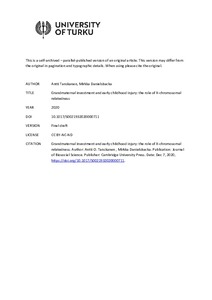Grandmaternal investment and early childhood injury: the role of X-chromosomal relatedness
Tanskanen Antti; Danielsbacka Mirkka
https://urn.fi/URN:NBN:fi-fe2021042822956
Tiivistelmä
Evolutionary theory posits that grandmothers can increase their
inclusive fitness by investing time and resources in their
grandchildren. According on the X-linked grandmother hypothesis, the
asymmetric inheritance of X-chromosomes should be responsible for the
biased effect of the investment by maternal and paternal grandmothers
towards granddaughters and grandsons. The British Millennium Cohort
Study (n=4445 children) was used to investigate the association between
grandmaternal childcare and children's injuries between the ages of 9
months and 3 years. Support was found for the X-linked grandmother
hypothesis predicting that the investment of paternal grandmothers
benefits more granddaughters than grandsons, the investment of paternal
grandmothers benefits granddaughters more than the investment of
maternal grandmothers, and the investment of maternal grandmothers is
similarly associated with the injuries of granddaughters and grandsons.
However, no support was found for the prediction that maternal
grandmothers benefit more grandsons than paternal grandmothers. Thus,
some, although not univocal, evidence for the prediction that
X-chromosomal relatedness shapes the grandmaternal effect on child
outcomes was found.
Kokoelmat
- Rinnakkaistallenteet [19207]
